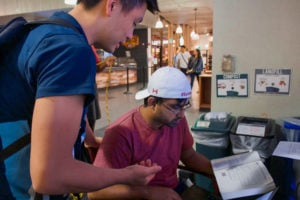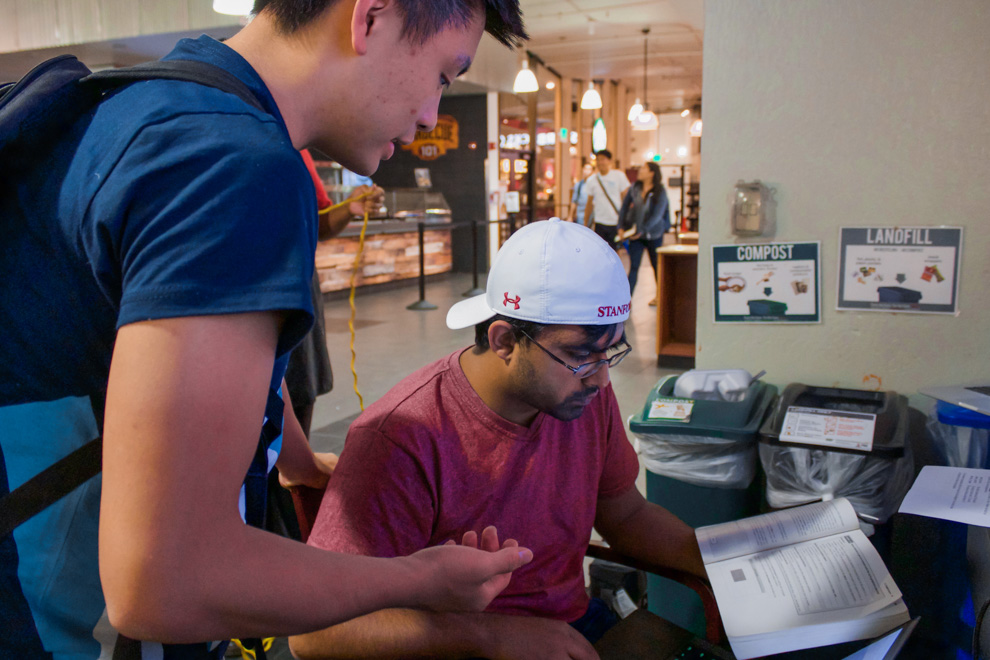It is 10:00 pm on Sunday and Tresidder Union is abuzz with activity; it is, after all, the night before this quarter’s second CS106A assignment is due. Computer science (CS) students flock to the first floor of Tressider, known as the LaIR, in search of help for their coding assignments. A well-oiled queue system allows them to submit help requests online, reserve a spot in the line and wait patiently for the call of a tutor.

From Sunday through Thursday evenings, the LaIR serves as a hub for CS106 students seeking tutoring from section leaders and course helpers. Everyone who works in the LaIR is a member of the CS198 program, a group of 90 undergraduate and graduate students responsible for teaching section for Stanford’s introductory CS courses: CS106A, CS106B, CS106X and CS106L.
Sonja Johnson-Yu ’18 has been a LaIR tutor and CS106A section leader since her junior year. She works a two-hour LaIR shift once a week, but rarely sees the same student twice — a typical tutor helps 7-8 students within a shift in a process that Sonja compares to “speed dating.”
Although her first time leading her section and tutoring in the LaIR was “nerve wracking,” Sonja believes her knowledge as a former CS106A student and experience tutoring have helped her feel more comfortable working at the LaIR.
“At first, you don’t know what’s coming at you,” she explained. “You only have the experience of having done the assignment yourself, but ultimately you find that the bugs aren’t that scary and are pretty explainable because you have the experience to understand what’s going on.”
The LaIR queue grows exponentially the night before a major deadline. Despite the atmosphere of panic, LaIR tutors have developed ways to stay on top of the increased workload. Sometimes, on particularly busy nights, the staff sends out a “LaIR SOS” message, where tutors come for additional backup.
“[The staff are] super patient, super calm and super helpful,” said CS 106A student Cade Crow ’20.”
Johnson-Yu attributes such success of the LaIR to the team spirit embodied by its tutors.
“The LaIR used to stress me out, but I really love working the LaIR because of the people on my shift,” she said. “Whenever there’s a sense of camaraderie among the LaIR helpers, it becomes a much more productive environment for both the students and for the people working there.”
While working at the LaIR can seem like a thankless job, Johnson-Yu says, she derives satisfaction from giving students the tools to figure out their bugs on their own.
“I think one of the most rewarding things about tutoring is when you sit down with a student, keep asking them questions and don’t even point out what’s wrong with their code, and they figure it out for themselves,” she said.
This technique is essential when students are easily able to compromise their understanding by relying too heavily on the help of LaIR tutors. Though LaIR tutors are specially dedicated resources for students in introductory computer science courses, Johnson-Yu believes overusing the LaIR can diminish a student’s effectiveness as budding computer scientists, which would only negate the benefits the LaIR has to offer.
Johnson-Yu remarked, “It’s one thing we don’t publicize, but I think a really important skill in CS is being able to figure out your problems for yourself.”
Johnson-Yu said she believes that introductory students tend to err on the side of caution and seek help more often than they actually need it. As a result, she has found that a major challenge in her work at the LaIR is, gauging how much help she should offer, and what sort of guidance students need most — ranging from conceptual guiding questions on a homework task to the nitty-gritties of using the debugging tools.
While it is often a challenge for tutors to customize their teaching styles to the large number of students who stream into the LaIR for help every night, students reported that the LaIR tutors’ attentiveness made them effective teachers as well as problem solvers.
“[LaIR tutors] don’t get annoyed. They really take the time to listen to what the student’s problem is rather than just trying to get through the problems really quickly,” said Crow.
Contact Alex Tsai at aotsai ‘at’ stanford.edu
